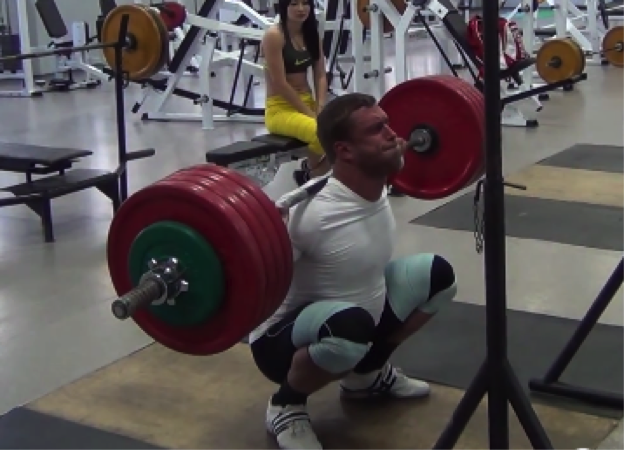Written by Chad Wesley Smith
There are tons of different exercise variations out there being touted as a fix to this weak point or the best exercise to improve such and such. Here is a simple guide to help you understand how to do some of these more important variations, why you would perform them and when they’re best to include in your training.
Safety Squat Bar (SSB) Squat
Technique Points:
-Squat mechanics are similar to the high bar squat (Watch our Squat Pillars series on YouTube)
-Actively flex your upper back
-Avoid pushing up or pulling down on the handles
Why To Do It:
-Addresses upper back rounding during squat
-Work around sore elbows/shoulders from low bar squatting
-Builds up quads with more overload than front squatting
When To Do It:
-Hypertrophy Blocks because they support high volume squatting and won’t interfere with Bench Press training
-Hypertrophy and Strength Blocks to address rounding over weak point
-Strength and Peaking Blocks to give your upper body a break from heavy low bar squats while still giving your lower body good training stimulus
Low Pin Squat/Dead Squat
Technique Points
-Set the pins about 1” below your typical sticking point in the Squat
-Focus on keeping your chest up while initiating the movement, don’t let it turn into a Good Morning
-If performing this out of chains/straps, avoiding rocking the weight to gain momentum
-These are best performed for singles or with a reset between each rep.
-Using a SSB may be needed on this to allow less mobile athletes to get into starting position
Why To Do It
-Overcoming a sticking point at just above parallel
-Building starting strength
-This can be an injury workaround if the very bottom of the squat is aggravating to a knee or hip issue
When To Do It
-Strength Blocks tend to be the best time to use this movement as a secondary exercise to your competition style squatting
Pause Squats
Technique Points
-Descend with the same speed you would in a normal squat
-Actively hold yourself in the squat, rather than just resting in the end range of motion
Why To Do It:
-Build up starting strength to overcome weakness out of the hole
-Ingrain better positions through extended time under tension
When To Do It:
-Hypertrophy. This is good option because of the longer time under tension but you’ll likely want to use slightly lower reps than you would with an unpaused squat, ie. sets of 8 instead of 10.
-Strength. This is a good time to use it as a primary exercise to address a weak point out of the hole.
-Peaking. Use Pause in the Hole Squats during peaking as a secondary movement to complement your competition squats.
Pause Above Parallel Squat
Technique Points
-Descend with the same speed you would in a normal squat
-Explode up to the point of the pause and come to a full, hard stop at just below (.5-1”) your normal sticking point
-Accelerate from the pause through the completion of the lift
Why To Do It
-Overcome a sticking point just above parallel
When To Do It
-Hypertrophy. This is good option because of the longer time under tension but you’ll likely want to use slightly lower reps than you would with an unpaused squat, ie. sets of 8 instead of 10.
-Strength. This is a good time to use it as a primary exercise to address a weak point out of the hole.
-Peaking. Use Pause Above Parallel Squats during peaking as a secondary movement to complement your competition squats.
Front Squat
Technique Points
-Front rack, crossed hands or straps are all fine for Powerlifters or General Strength training
-Keep pressure through full foot and drive knees forward as ankle mobility will allow
-Anticipate the reversal out of of the hole
Why To Do It:
-Build up quad strength at lower fatigue cost than high bar squat
-Helps address rounding over or relatively weak legs weak points
When To Do It:
-Hypertrophy Blocks because they support high volume squatting at slightly lower fatigue costs and won’t interfere with Bench Press training
-Strength Blocks are possible too if used as a secondary or tertiary variation to build up volume at lower fatigue cost while addressing rounding over or weak legs weak point.
Belt Squat
Technique Points
-Wear the belt low on your hips so that you can keep a very upright posture
-Focus on pushing your knees forward to emphasize pressure in your quads
Why To Do It
-Focus on building quad strength to overcome an issue of relatively strong back/weak legs
-Add squat volume at a low fatigue cost
-Workaround low back or upper body injuries that are hindering traditional squat training
When To Do It
-Hypertrophy Phase. This is the best option because belt squats lend themselves to high volume and won’t interfere with with Bench or Deadlift training
-Strength Phase. Belt Squats can be useful here as an assistance movement to bring up leg strength relative to back strength.
-Peaking Phase. Belt Squats have a limited use here but could be included to keep volume up for less experienced lifters












